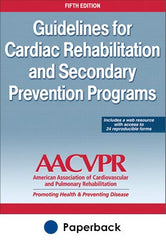Education, monitoring, and management of patients with diabetes
This is an excerpt from Guidelines for Cardiac Rehabilitation and Secondary Prevention Programs 5th Edition With Web Resource by AACVPR.
Education, Monitoring, and Management of Patients With Diabetes
There are a number of precautions and special instructions for exercise in persons with diabetes as listed in “General Precautions for Patients With Diabetes.” Complications involving the feet are common in people with diabetes; therefore foot care is an important consideration. Problems most often develop in patients with peripheral neuropathy of legs and feet and when blood flow is compromised. Such problems can include extremely dry skin that may peel or crack; calluses that may ulcerate; and foot ulcers, particularly at the ball of the foot or at the base of the big toe. Patients should be routinely taught to inspect their feet and report any sores, infections, or inflammation to their health care provider. In addition to regular inquiry by the health care staff regarding foot health, initial assessment for peripheral neuropathies and pulses should be performed. CR/SP staff should instruct patients on routine foot care.12 General precautions for patients with diabetes are covered in the following list.
General Precautions for Patients With Diabetes
- Avoid vigorous exercise before blood glucose has been adequately controlled.
- Have knowledge and awareness of the signs, symptoms, and management of hypoglycemia and hyperglycemia; exercise late in the evening may increase risk of nocturnal hypoglycemia.
- Some medications may mask or exacerbate exercise-related hypo- or hyperglycemia, including beta-blockers, diuretics, calcium channel blockers, and warfarin.
- Take appropriate precautions:
- Always carry a carbohydrate (CHO) source.
- Avoid exercise at time of peak insulin effect; alternatively, consume a CHO snack 30 min before exercise or decrease insulin or oral hypoglycemic dose before exercise; schedule exercise 1 to 2 h after meals.
- Test blood glucose frequently; responses may vary with each individual and day to day.
- Hydrate adequately before, during, and after exercise.
- Use caution when exercising in the heat. Temperature regulation may be impaired in some patients with diabetes.
- Carry a personal ID at all times specifying diabetes along with emergency contacts.
- Public or cell phone access is important.
- Inject insulin abdominally before exercise commencing within 30 min; do not use active muscles as injection sites for insulin preexercise.
- Patients with neuropathy
- may require alternatives to palpating pulse for controlling intensity (e.g., commercial heart rate monitor or use of rating of perceived exertion),
- may have abnormal heart rate and blood pressure responses to exercise,
- are at increased risk of orthostatic hypotension, and
- should routinely care for their feet and hands.
Instructions for Foot Care to Patients With Diabetes
Foot hygiene
- Inspect your feet daily for blisters, cuts, and scratches; report any issues to your health care provider immediately. If appropriate, a family member may assist with foot inspection.
- Inspect the interior and the soles of your shoes on a daily basis for roughness or inconsistent wear.
- It is helpful to have and alternate two pairs of shoes on a daily basis for exercise.
- Wash and dry feet carefully every day, giving special attention to areas between the
toes. - Dry skin may be relieved with application of baby oil after bathing and drying feet or hands.
- Do not soak your feet.
- Avoid bathing in extreme temperatures.
- Cut toenails straight across.
- Do not cut or trim corns; do not treat corns and calluses with chemical agents.
- Do not use adhesive tape on feet.
Note: The health provider or physician should examine feet at each visit.
Footwear
- Wear properly fitted, synthetic or wool socks, pantyhose, and so on. Avoid mended stockings or stockings with seams that may irritate the feet. Change socks and stockings daily.
- Wear wool socks with protective footwear in the winter.
- Wear socks if your feet are cold at night.
- Buy comfortable shoes made of materials that provide protection for your feet and keep your feet dry.
- Do not wear sandals with thongs between the toes.
- Do not walk barefoot, especially on hot surfaces.
Monitoring BG levels is vital for the long-term maintenance of glycemic control and is especially important during exercise given that beta-blocker therapy can mask the onset of an impending insulin reaction. Monitoring BG levels during exercise may also provide positive feedback regarding the regulation or progression of the exercise prescription, which may result in subsequent long-term adherence to exercise. This is particularly important since exercise is a cornerstone of treatment for diabetes.
http://www.humankinetics.com/AcuCustom/Sitename/DAM/097/127tab10_Main.png
http://www.humankinetics.com/AcuCustom/Sitename/DAM/097/127tab11_Main.png
http://www.humankinetics.com/AcuCustom/Sitename/DAM/097/128tab12_Main.png
Learn more about Guidelines for Cardiac Rehabilitation and Secondary Prevention Programs Fifth Edition (With Web Resource).
More Excerpts From Guidelines for Cardiac Rehabilitation and Secondary Prevention Programs 5th Edition With Web Resource

Get the latest insights with regular newsletters, plus periodic product information and special insider offers.
JOIN NOW


